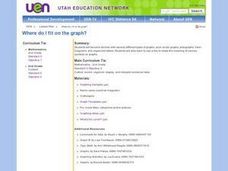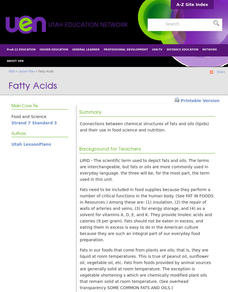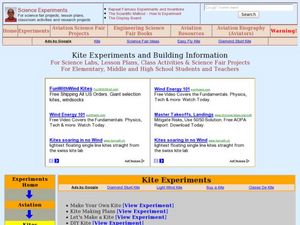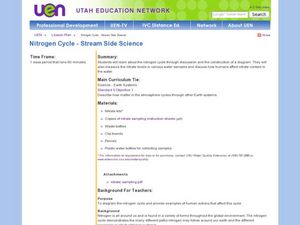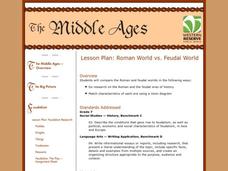Curated OER
Measuring Techniques - Level I
Demonstrate food preparation techniques of salads, soups, casseroles, breads, meats, poultry and pastries.
Curated OER
Where Do I Fit on the Graph?
Students collect data and create graphs about themselves, their community, and the world around them. They use a variety of methods to organize data, such as stickers, clothespins, name tags, coloring, tally marks, etc.
Curated OER
Yeasts and Molds
Students investigate the characteristics and nature of yeast and molds help to explain how these microorganisms affect food production. They experiment with yeast in sourdough in preparing sourdough pancakes.
Curated OER
Fatty Acids
Identify the properties of fats and lipids. Compare the properties of saturated and unsaturated fatty acids Identify foods containing triglycerides and identify which foods contain saturated and unsaturated fat Discuss the function of...
Curated OER
Web of Life - Role-Playing
Students role-play how organisms adapt to their environment. They play 20 questions with plant and animal habitats. They create a web of life to demonstrate how each plant and animal relies on the other for survival.
Curated OER
Drinking and Driving
Students select resources relating to alcohol relate dissues of drinking and driving. They explain the dangers of mixing drinking and driving. Students discuss the dangaer of drinking and driving using notes from Internet investigations....
Curated OER
A Newspaper?
Sixth graders use newspapers to investigate fractions. They work in small groups to categorize articles, measure them with the grid transparency, and calculate the values represented. Afterward, they write a reflective essay on the role...
Curated OER
Kite Experiments and Building Information
Young scholars build their own kite following certain procedures. In this physics lesson, students explain the aerodynamics concepts involved in flying kites. They trace the development of aviation.
Curated OER
Closing the Salary Gap
Students explore careers in their community and compare the average salaries for men and women working in those careers. They explore a variety of careers available in their community through participating in this lesson plan.
Curated OER
Cold War Era Film Censorship: High Noon- a Slice of Americana Or Communist
Students study of the effects of the Cold War on the home front. They analyze the film High Noon according to an abbreviated version of the standards that films were judged by in the early 1950s and determine whether or not High Noon is...
Curated OER
Missing Macroinvertebrates - Stream Side Science
Field study groups collect samples of stream water and identify the macroinvertebrates found. Using their data, they calculate a water quality index to rate the health of the stream. They graph their data and discuss the value of a water...
Practical Money Skills
Cars and Loans
Most teenagers want to buy a car, but do they know how much it really costs? Calculate the cost of purchasing a car, securing auto insurance, and maintaining the new investment with a thorough and engaging personal finance instructional...
Curated OER
Nitrogen Cycle-Stream Side Science
A thorough background and nitrate sampling lab sheet are provided to share with your young scientists. After discussing the nitrogen cycle with the class, you will break them into small groups and show them how to use their inquiry...
US Institute of Peace
Organizations Working for Peace
From helping refugees to negotiating peace treaties, the peacekeepers of the world keep busy! Introduce young activists to the many individuals and organizations throughout the world that work daily toward peace. 14th in a series of 15...
Curated OER
China's 'One Child Policy'
Students use an extract from Beth Gilligan's Voices and Values: Citizenship in Asia (Curriculum Corporation, 1998, pp 29-30), together with other resources, as the basis for investigation and analysis of China's 'one child policy'.
Curated OER
Fuel Cell Experimentation
With rising oil prices and increasing concerns over global warming, the pressure is on for engineers to develop alternative sources of energy. Among the new technologies being developed are hydrogen fuel cells, which young scientists...
Northeastern Educational Television of Ohio, Inc.
Roman World vs. Feudal World
Young historians compare the major features of the Roman and feudal worlds, such as religion, social hierarchy, and political tenets, using online resources and group discussion.
University of the Desert
What Is Extremism?
By participating in discussions using prompts and statements provided in the lesson plan, learners identify the concept of extremism and consider what causes violent acts of extremism in the modern world.
Practical Money Skills
Understanding Credit
Help your young consumers learn about credit and the importance of credit history. With a thorough lesson about the ins and outs of credit, as well as the potential pitfalls of having a line of credit, kids will be well-equipped to...
Curated OER
My Living Arrangements
Students identify various housing options, focusing on rental vs. purchase and short vs. long term. With a partner, students discuss their housing situation. Once their discussion is complete, students write a brief paragraph weighing...
Curated OER
Dictatorship
Fifth graders research world history by researching democracy. In this dictatorship lesson, 5th graders read the story "The Composition" and identify a list of former dictators on the Internet. Students define several key terms and...
Curated OER
Australia: the Land Down Under
Students give a solid history and geographic explanation of the country of Australia and explain why it is important. They use some creativity in designing their own island, by using the physical features of this particular country.
Curated OER
Communication
Students identify good listening and talking skills and discuss verbal, written, and non-verbal communication. They create collages of magazine pictures demonstrating non-verbal communication.
Curated OER
Rock Cycle
Fourth graders participate in a Rock Cycle game to gain an understanding of the cycles that form metamorphic, sedimentary and igneous rocks.



